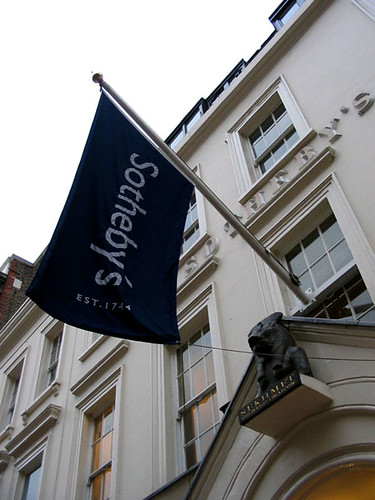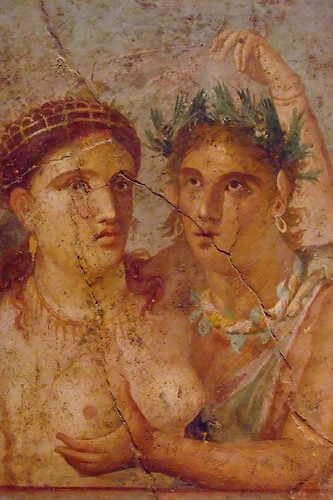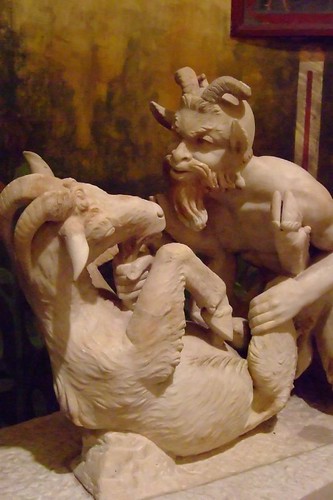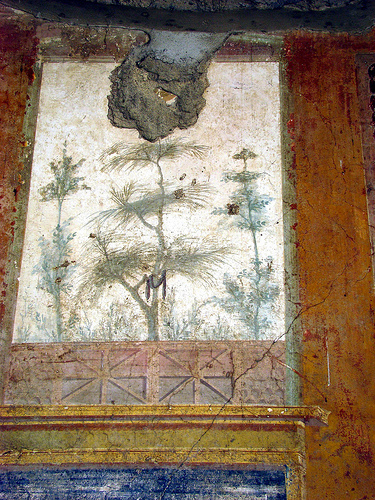 A precious Roman wall painting, stolen from the site of an ancient villa near Pompeii, has been returned to Italy, after 12 years circulating on the nebulous antiquities market.
A precious Roman wall painting, stolen from the site of an ancient villa near Pompeii, has been returned to Italy, after 12 years circulating on the nebulous antiquities market.
The fragment of plaster fresco originally came from a Roman villa at Boscoreale, just outside Pompeii, and was reported stolen from an archaeological warehouse at Pompeii in 1997.
The fresco is a typically Pompeian scene showing a woman dressed in green carrying a dish or tray against a cream background, surrounded by a deep red frame. Another part of the fragmented wall fresco, depicting Dionysos, was recovered from a London art gallery in 2008, according to this report on PR Newswire. The villa at Boscoreale was abandoned in the 79 AD eruption of Vesuvius.
A 2,600-year-old Corinthian vase was also repatriated, having been recovered from Christie’s auction house in New York. The vase dates from the sixth century BC and is thought to come from an Etruscan rock-cut tomb near Rome. The large column vase was originally used to mix wine and water and is decorated with black-figure animals on the lower band, with human figures on the upper band.
The two objects were due for auction in New York earlier this year before they were recognised as being of dubious provenance. Customs officials seized them in June. Associated Press reported that an Italian representative welcomed the antiquities back into the country last Wednesday, 2 December.
The Medici Conspiracy
It is thought that the vase may have found its way onto the antiquities market via convicted arts trafficker Giacomo Medici (sentenced to 10 years in jail in Rome in 2004). Medici was responsible for selling hundreds of illegally-obtained Greek, Roman and Etruscan objects on the art market. In 2006, his dodgy dealings were the subject of a book The Medici Conspiracy: The Illicit Journey of Looted Antiquities from Italy’s Tomb Raiders to the World’s Greatest Museum, by Peter Watson and Cecilia Todeschini.
How the two objects ended up at the New York auction is a matter of some concern. As David Gill, a classics scholar from the University of Wales, Swansea, notes in his Looting Matters blog, prominent auction houses have been known to list items subsequently found to have non-legitimate origins.
He writes that: It is a matter of concern that two auction-houses – Christie’s and Bonham’s – have been willing to offer material from sales that are known to have contained material supplied by Medici and his associates. Why did their due diligence processes fail to identify the potential problem with this particular “provenance”? Auction-houses need to be very wary of antiquities that first appeared at Sotheby’s in London during the 1980s and 1990s.
The return of the Corinthian vase and the Boscoreale fresco comes at a time when the legality of more high profile artefacts is also being questioned. Dr Zahi Hawass of Egypt’s Supreme Council of Antiquities is in negotiations with German officials to discuss the future of the Bust of Nefertiti, currently housed at Berlin’s Neues Museum, while he has also invited officials from Italy and Greece to join a conference on the return of antiquities. Last month, the BBC reported the passing of the Holocaust (Stolen Art) Restitution Act, which has set a new precedent in allowing art institutions and museums in Britain to return objects that were looted by the Nazis during the Second World War.
Photo by Alex Segre on Creative Commons licence.
 The red carpet was rolled out yesterday at one of Rome’s more unusual archaeological sites, while a discreet police presence also surrounded the visit of the president of the Italian Republic, Giorgio Napolitano to Palazzo Valentini. President of the Province of Rome, Nicola Zingaretti, called it an historic day, as Palazzo Valentini prepared to open its doors to visitors to the Roman archaeological complex
The red carpet was rolled out yesterday at one of Rome’s more unusual archaeological sites, while a discreet police presence also surrounded the visit of the president of the Italian Republic, Giorgio Napolitano to Palazzo Valentini. President of the Province of Rome, Nicola Zingaretti, called it an historic day, as Palazzo Valentini prepared to open its doors to visitors to the Roman archaeological complex  The first domus found at the site dates from 150 AD, which is probably when the first domus was built (although it would have been subsequently developed). The second domus was build during the time of emperors
The first domus found at the site dates from 150 AD, which is probably when the first domus was built (although it would have been subsequently developed). The second domus was build during the time of emperors  Palazzo Valentini, built in 1585, is named after the Prussian banker, Vincenzo Valentini, who bought the building in 1827. He lived there and also carried out architectural improvements, while also housing his art collection there. Since 1873, Palazzo Valentini has been the headquarters of the local authority, Provincia di Roma.
Palazzo Valentini, built in 1585, is named after the Prussian banker, Vincenzo Valentini, who bought the building in 1827. He lived there and also carried out architectural improvements, while also housing his art collection there. Since 1873, Palazzo Valentini has been the headquarters of the local authority, Provincia di Roma. Historians and archaeologists are having to rethink the
Historians and archaeologists are having to rethink the  Most of the known Roman remains in Wales are from military camps and forts. There were large legionary bases at
Most of the known Roman remains in Wales are from military camps and forts. There were large legionary bases at 

 However, Hawass also reveals that he is not entirely without his superstitious side. He himself experienced an odd series of events surrounding his own examination of the body and tomb of
However, Hawass also reveals that he is not entirely without his superstitious side. He himself experienced an odd series of events surrounding his own examination of the body and tomb of 

